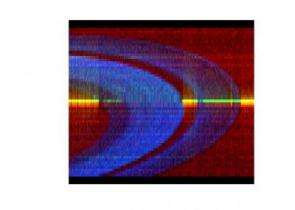New Cassini image shows "A" ring contains more debris than once thought

Views of Saturn's stunning ring system from above by the Cassini-Huygens spacecraft now orbiting the planet indicate the prominent A ring contains more debris than once thought, according to a new University of Colorado at Boulder study.
Previous observations with the Voyager spacecraft in the early 1980s found the ring was more transparent, indicating less material, said Joshua Colwell of CU-Boulder's Laboratory for Atmospheric and Space Physics. But new calculations based on May 2005 observations with Cassini's Ultraviolet Imaging Spectrograph, or UVIS, indicates the opacity of the ring is up to 35 percent higher than previously reported.
Because of the uneven distribution of the ring particles - which range in size from dust grains to school buses - the transparency of the rings depends on the angle from which they are viewed, he said. The particles are arranged essentially parallel in long stringy clumps as large as 60 feet across, 16 feet thick and 160 feet long, according to models produced from observation data, said Colwell.
A paper on the subject by Colwell, Larry Esposito and Miodrag Sremcevic of CU-Boulder's LASP appears in the April 1 issue of Geophysical Research Letters, or GRL. Esposito is science team leader for UVIS, a $12.5 million instrument designed and built at CU-Boulder by LASP that is riding on the Cassini spacecraft.
A new image released by the team in conjunction with the GRL paper shows the distribution of the ring material. The opaque B ring has more material than the A ring, located just outside it, and the A ring is densest near its inner edge, according to the team. The new clumps observed by Cassini mean a larger amount of material overall said Colwell, a LASP research associate and UVIS science team member.
The particles are trapped in ever-changing clusters of debris that are regularly torn apart and reassembled by gravitational forces from the planet, Colwell said. The size and behavior of the clusters were deduced by observing flickering light as the ring passed in front of a star in a process known as stellar occultation, he said.
"The flickers are like a time-lapse movie of a car's headlights taken from the other side of a picket fence," said Colwell. "The flickering would provide us details about the pickets."
The observations of the particle clusters indicate the A ring is primarily empty space. A close-up view of the rings would show as "short, flattened strands of spiral arms with very few particles between them," he said.
Source: University of Colorado at Boulder


















